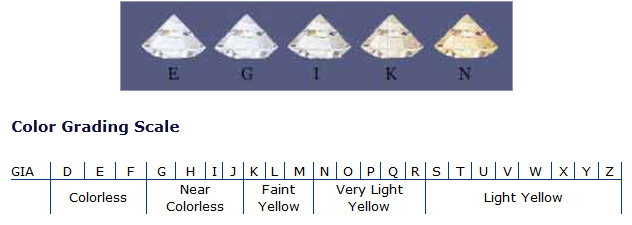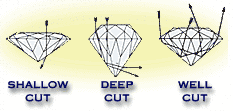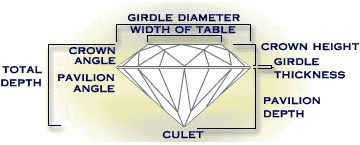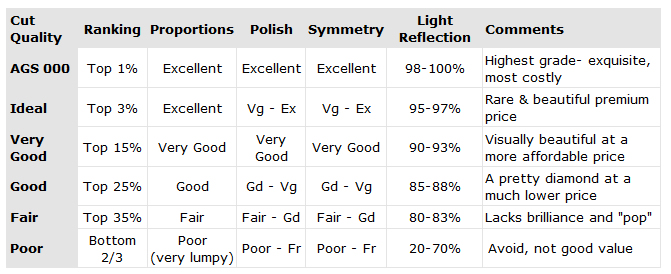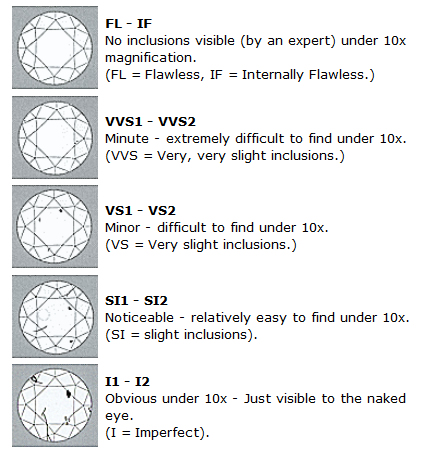Carat
The weight of a diamond is precisely measured in carats. The greatest majority of diamonds mined are very small in size and larger sizes command much higher prices. Diamond value tends to rise exponentially with carat weight. Learn how you can get the most value by selecting a diamond in the upper range of a size category.
Carat, abbreviated ct., is the unit of measurement for the weight of a diamond. 1.00 ct. represents 100 points, or one full carat. A carat is equivalent to 0.2 grams. 100 Points equals 200 milligrams (.2 g) or 1 carat. Accuracy, in most cases, is precise to less than 1/100,000 ct.
Color
Color refers to the absence or presence of body color in a diamond. The most valuable diamonds are either totally colorless or rich fancy colors. Those that fall in between with varying amounts of slight body color are graded on a strict alphabetical scale. Diamonds with the slightest degree of color appear more brilliant. Learn what color ranges appear white to the untrained eye and offer good value.
Most diamonds, although appearing colorless, actually have slight tones of yellow or brown. As these tones become more easily apparent, the rarity and the cost decrease.
Cut
The cut of a diamond not only refers to the shape but more importantly to how well a diamond is proportioned and polished. The exactness of the cutting has the greatest effect on its brilliance and sparkle. If a diamond is not well cut, it will not exhibit maximum beauty regardless of how high its color and clarity are. Learn how you can determine the cut quality of diamonds and avoid common deceptions.
Cut is the primary determinacy of a diamond’s brilliance. Cut consists of proportions, symmetry, and polish. The precision of how facets are applied, angles derived, uniformity of shape, and final polish all affect the beauty of a diamond. Cut is considered the most important diamond characteristic because it has the most dramatic effect on appearance and can affect the value of a diamond by up to 60%! A poorly cut diamond will have a dulled brilliance.
Proportions
It has been shown through numerous studies that specific angles and relationships of depth compared to width of the diamond determine how well light will reflect back to the eye. A diamond that is cut too shallow will appear washed out and lifeless because incorrect angles allow light to leak out of the pavilion instead of reflecting back out the top. One that is cut too deep will appear dark as light is reflected poorly and will also appear small for its weight due to the excess depth.
Symmetry
This refers to the alignment of a diamond’s facets. Poor alignment can cause light to be misdirected and create distortions in the pattern of brilliance and sparkle. Such distortion is confusing to the eye and very undesirable.
Polish
Because diamonds possess a great hardness they have a very high luster when polished. The degree of skill when polishing can greatly affect the overall brilliance and sparkle of a diamond. Poor or marginal polish can make a diamond look dull or oily. Very good or excellent polish really makes a diamond “pop”! Cut quality is based on how well a diamond is able to reflect light. The chart below can be used to explain the differences that cut quality can have on light reflection.
AGS triple zero: A diamond certified by the AGS laboratory receiving the grade of excellent for cut category (proportions, symmetry, and polish). Such a diamond reflects nearly all light that enters it and represents the top 1% of diamond quality based on cut.
Clarity
This refers to the absence or presence of flaws (called inclusions) on or in a diamond. Diamonds with few or no inclusions are very rare and valued highly. Clarity is graded using the GIA scale based on the size, number, location, and type of inclusions found in a diamond. At Earth Treasures, we can teach you how to select the right clarity for beauty within your budget.
Practically all diamonds contain naturally occurring internal characteristics called inclusions. The size, nature, location and amount of inclusions determine a diamond’s clarity grade and affect its cost.
Certificate
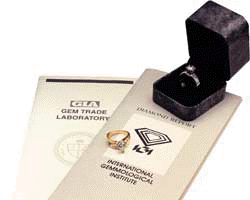
Certification is a laminated report based on an in-depth analysis of a loose diamond by an independent laboratory for the protection of both the buyer and seller. Always graded by a minimum of three Graduate Gemologists, it never puts a monetary value on the diamond, but includes all the specifics of carat weight, color, clarity, and cut necessary to properly determine value. With the help of an educated highly trained jeweler / gemologist, the consumer can make comparisons necessary to confidently choose the right diamond.
The three internationally recognized and most respected laboratories for certifying diamonds are:
- GIA – Gemological Institute of America
- IGI – International Gemological Institute
- AGS- American Gem Society Laboratories
Earth Treasure’s Diamonds are Certified
A laboratory certificate accompanies every loose diamond sold by Earth Treasures from one of the above laboratories eliminating any possible concerns of misrepresentation or exaggerated claims.
View Certificates for Comparisons
You can view certificates of our diamonds online and even speak to one of our knowledgeable gemologists to answer any questions you might have. Click on the different certificates below to familiarize yourself with the information disclosed on each version.
- AGS Diamond Quality Document
- IGI Laboratory Report
- GIA Diamond Grading Report
Cost
All of the above C’s must be factored in plus other subjective criteria in order to arrive at a fair selling price. One must realize, though, that diamonds are not cookie cutter duplicates of each other. Two diamonds of seemingly matching qualities can appear very different when compared side by side and command different prices. Profit margins must be considered, but more importantly, the level of service before, during, and after the transaction. Learn why you’ll experience greater satisfaction with a purchase from Earth Treasures.
The price of each diamond is determined by the previous 5 factors above. All these must be taken into consideration when pricing a diamond, since no two are exactly alike. Remember, cut is 40-60% of the price of the diamond, so when comparing Certified Diamonds of the same color and clarity, cut should be the deciding factor.
Here at Earth Treasures we offer excellent value (our gemologists buy from cutters and importers directly) with exceptional service (no one has a more dedicated, extensively educated staff) and commitment (before and after the sale) to our customers.


